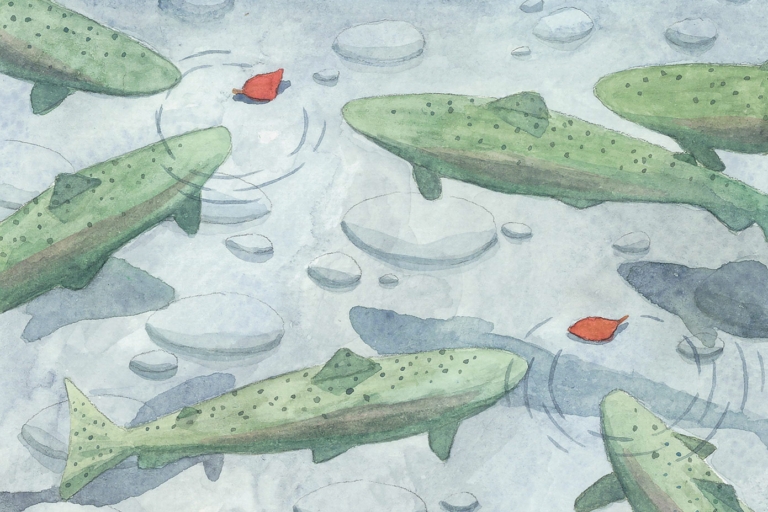Almost Two Decades Watching Wild Salmon from the Same Perch
As I wake, I become aware of the shovel-scraping-asphalt croak of a blue heron, or the brilliant complex cascading song of the winter wren, or the yammering calls of the kingfisher being chased by an accipiter. In the fall a flock of kinglets, moving through the trees and shrubs surrounding our camp, deliver their pure, clear whistles. From the pool comes the splash of a steelhead turning. The rain dropping to the tarps from the giant fir that has grown old at the edge of the creek makes its own sound.
I am reasonably sure, however, what wakes Sis, my fifteen-year-old heeler companion, are the vibrations of my movement toward the front end of the Airstream trailer. Though happy and spry—still able to take stair steps three at a bound on a good afternoon—she has become largely deaf. As a backdrop, the main creek is almost booming if it is in spate, or burbling with musical overtones when it is low enough for boulders to surface in the riffles below the pool.
Sis and I negotiate the short zigzag trail down to the viewing area, a small terrace carved out fifteen feet above the creek. We settle on a wooden observation platform constructed next to the base of a twisted old-growth fir. This is our perch. It is located over the middle of a moderate-sized pool that—from late spring through late autumn—contains an average of about 150 wild summer steelhead. From our perch, we can see the steelhead fifty to eighty feet away in water that is usually clear enough to determine, for instance, whether an individual is a male or a female. Once the cooler days and nights of autumn arrive, the clarity of the creek becomes such that I can even tell which way a steelhead is looking.

Illustration: Cathy Eliot
For seventeen years I have spent much of my time from mid-May through early to middle December seated at this perch, watching the fish and whatever else is happening around the pool. These large groups of steelhead had been a target of poaching for more than fifty years prior, after logging roads were extended into the middle reaches of this basin. We form a deterrent to this activity, once so pervasive that locally the pool is called The Dynamite Hole. The explosions used to happen once or twice a year, leading to multiple snags. Beyond the dynamiting, the frequency of poaching, on and off all season long, caused serious damage to the populations of wild summer steelhead.
Lest we come down too hard on local people in this regard, we should bear in mind that the smaller and smaller numbers of wild adult salmon returning to their natal streams and the loss of local breeding populations along the eastern edge of the North Pacific was not brought about by poaching … or by seals or otters … or, for that matter, by the gill nets of indigenous peoples. The fundamental problem continues to be our blind reliance on hatcheries, our continuing industrial assault on primal ecologies, and our population numbers. So the summer steelhead have found their refuge, and this refuge needs a caretaker. Presently, Sis and I fulfill that duty, and we know we are lucky to have the opportunity to do something that is altogether so straightforward, so positive, and so helpful to these wild fish we have grown to admire. We are lucky, as well, to be able to live so simply during our time here.
Excerpted from A Temporary Refuge: Fourteen Seasons With Wild Summer Steelhead by Lee Spencer.

As featured in the documentary, DamNation (Patagonia, 2014)
A distillation of fourteen years of detailed observations, in this surprisingly engaging almanac, Spencer records a natural history teeming with fish, water, vegetation, birds, mammals, insects, reptiles and amphibians, seasonal changes, and interesting events and stories. Spencer is a modern-day Thoreau, and the steelhead pool is his Walden Pond.
“From these pages flows the elusive beauty that compels, the defense of wild rivers.” – Matt Stoecker, ecologist and producer of DamNation (Patagonia, 2014)

